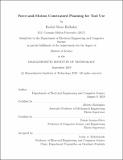| dc.contributor.advisor | Alberto Rodriguez and Tomás Lozano-Pérez. | en_US |
| dc.contributor.author | Holladay, Rachel Mara. | en_US |
| dc.contributor.other | Massachusetts Institute of Technology. Department of Electrical Engineering and Computer Science. | en_US |
| dc.date.accessioned | 2020-03-09T18:59:10Z | |
| dc.date.available | 2020-03-09T18:59:10Z | |
| dc.date.copyright | 2019 | en_US |
| dc.date.issued | 2019 | en_US |
| dc.identifier.uri | https://hdl.handle.net/1721.1/124127 | |
| dc.description | This electronic version was submitted by the student author. The certified thesis is available in the Institute Archives and Special Collections. | en_US |
| dc.description | Thesis: S.M., Massachusetts Institute of Technology, Department of Electrical Engineering and Computer Science, 2019 | en_US |
| dc.description | Cataloged from student-submitted PDF version of thesis. | en_US |
| dc.description | Includes bibliographical references (pages [41]-47). | en_US |
| dc.description.abstract | The use of hand tools presents a challenge for robot manipulation in part because it calls for motions requiring continuous force application over a whole trajectory, usually involving large joint-angle excursions. The feasible application of a tool, such as pulling a nail with a hammer claw, requires careful coordination of the choice of grasp and joint trajectories to ensure kinematic and force limits are not exceeded - in the grasp as well as the robot mechanism. In this thesis, we formulate this type of problem as choosing the values of decision variables in the presence of various constraints. We evaluate the impact of the various constraints in some representative instances of tool use. To aid others in further investigating this class of problems, we have released materials such as printable tool models and experimental data. We hope that these can serve as the basis of a benchmark problem for investigating tasks that involve many kinematic, actuation, friction, and environment constraints. | en_US |
| dc.description.statementofresponsibility | by Rachel Mara Holladay. | en_US |
| dc.format.extent | 50 pages | en_US |
| dc.language.iso | eng | en_US |
| dc.publisher | Massachusetts Institute of Technology | en_US |
| dc.rights | MIT theses are protected by copyright. They may be viewed, downloaded, or printed from this source but further reproduction or distribution in any format is prohibited without written permission. | en_US |
| dc.rights.uri | http://dspace.mit.edu/handle/1721.1/7582 | en_US |
| dc.subject | Electrical Engineering and Computer Science. | en_US |
| dc.title | Force-and-motion constrained planning for tool use | en_US |
| dc.type | Thesis | en_US |
| dc.description.degree | S.M. | en_US |
| dc.contributor.department | Massachusetts Institute of Technology. Department of Electrical Engineering and Computer Science | en_US |
| dc.identifier.oclc | 1142635518 | en_US |
| dc.description.collection | S.M. Massachusetts Institute of Technology, Department of Electrical Engineering and Computer Science | en_US |
| dspace.imported | 2020-03-09T18:59:09Z | en_US |
| mit.thesis.degree | Master | en_US |
| mit.thesis.department | EECS | en_US |
